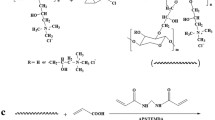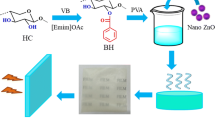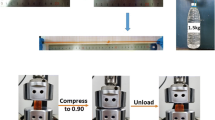Abstract
Improving the mechanical performance of hemicellulose-based hydrogel is an enormous challenge. Here, we propose a new strategy to achieve the hemicellulose-based hydrogels with superior mechanical performance through chain extension and semi-interpenetrating polymeric networks (semi-IPN). Xylan, known as the main type of hemicelluloses in angiosperms, is successfully modified to increase molecular weight by reductive amination reaction, overcoming the major limitation of brittleness. Then, the chemical network is obtained by graft copolymerizing acrylic acid (AA) with cross-linking agent N,N′-methylenebisacrylamide (MBA) in the presence of chain extended xylan (CEX). With the further introduction of ferric ions, a physical network is constructed via metal–ligand interactions. Such a xylan-based semi-IPN hydrogel shows excellent mechanical properties with a fracture tensile stress of 1.4 MPa, compression stress of 0.59 MPa, and the elongation at break of 1136%. In addition, the hydrogel also exhibits fine water absorbency (213.6 g/g) and high electrical conductivity (4.76 × 10–3 S/m). We anticipate that the resultant xylan-based semi-IPN hydrogels will open up a new approach for the design of high performance hemicellulose-based soft materials.





Similar content being viewed by others
References
Anas IY, Ulrica E, Ann CA (2015) Enhanced formability and mechanical performance of wood hydrolysate films through reductive amination chain extension. Carbohyd Polym 117:346–354
Aziz SH, Ansell MP (2004) The effect of alkalization and fibre alignment on the mechanical and thermal properties of kenaf and hemp bast fibre composites: part 1-polyester resin matrix. Compos Sci Technol 64:1219–1230
Azizullah N-u-R, Liu W, Haider A, Kortz U, Sohail M, Joshi SA, Iqbal J (2016) Novel gelatin-polyoxometalate based self-assembled pH responsive hydrogels: formulation and in vitro characterization. Des Monomers Polym 19:697–705
Bush JR, Liang H, Dickinson M, Botchwey EA (2006) Xylan hemicellulose improves chitosan hydrogel for bone tissue regeneration. Polym Adv Technol 27:1050–1055
Cao XF, Peng XW, Zhong LX, Sun RC (2014) Multiresponsive hydrogels based on xylan-type hemicelluloses and photoisomerized azobenzene copolymer as drug delivery carrier. J Agric Food Chem 62:10000–10007
Ebringerová A, Kardosová A, Hromádková Z, Malovíková A, Hríbalová V (2002) Immunomodulatory activity of acidic xylans in relation to their structural and molecular properties. Int J Biol Macromol 30:1–6
Edlund U, Albertsson AC (2012) SET-LRP goes green: various hemicellulose initiating systems under non-inert conditions. J Polym Sci Part A-Polym Chem 50:2650–2658
Fei RC, George JT, Park J, Means AK, Grunlan MA (2013) Ultra-strong thermoresponsive double network hydrogels. Soft Matter 9:2912–2919
Gao CD, Ren JL, Kong W, Sun RC, Chen Q (2015) Comparative study on temperature/pH sensitive xylan-based hydrogels: their properties and drug controlled release. RSC Advances 5:90671–90681
Gong JP, Katsuyama Y, Kurokawa T, Osada T (2003) Double-network hydrogels with extremely high mechanical strength. Adv Mater 15:1155–1158
Guan Y, Zhang B, Bian J, Peng F, Sun RC (2014) Nanoreinforced hemicellulose-based hydrogels prepared by freeze–thaw treatment. Cellulose 21:1709–1721
Hansen NML, Plackett D (2008) Sustainable films and coatings from hemicelluloses: a review. Biomacromol 9:1493–1505
Haraguchi K, Li HJ (2005) Control of the coil-to-globule transition and ultrahigh mechanical properties of PNIPA in nanocomposite hydrogels. Angew Chem Int Ed 44:6500–6504
Heidarian P, Behzad T, Sadeghi M (2017) Investigation of cross-linked PVA/starch biocomposites reinforced by cellulose nanofibrils isolated from aspen wood sawdust. Cellulose 8:3323–3339
Huang T, Xu H, Jiao K, Zhu L, Brown HR, Wang H (2007) A novel hydrogel with high mechanical strength: a macromolecular microsphere composite hydrogel. Adv Mater 19:1622–1626
Hussain I, Sayed SM, Liu S, Oderinde O, Yao F, Fu G (2018) Glycogen-based self-healing hydrogels with ultra-stretchable, flexible, and enhanced mechanical properties via sacrificial bond interactions. Int J Biol Macromol 117:648–658
Imran AB, Seki T, Takeoka Y (2010) Recent advances in hydrogels in terms of fast stimuli responsiveness and superior mechanical performance. Polym J 42:839–851
Ito K (2007) Novel cross-linking concept of polymer network: synthesis, structure, and properties of slide-ring gels with freely movable junctions. Polym J 39:489–499
Ito K (2010) Slide-ring materials using topological supramolecular architecture. Curr Opin Solid State Mater Sci 14:28–34
Liu XX, Lin QX, Yan YH, Peng F, Sun RC, Ren JL (2018) Hemicellulose from plant biomass in medical and pharmaceutical application: a critical review. Curr Med Chem 24:1–21
Li XM, Pan XJ (2010) Hydrogels based on hemicellulose and lignin from lignocellulose biorefinery: a mini-review. J Biobased Mater Bioenerg 4:289–297
Okumura Y, Ito K (2001) The polyrotaxane gel: a topological gel by figure-of-eight cross-links. Adv Mater 13:485–487
Peng F, Ren JL, Xu F, Bian J, Peng P, Sun RC (2009) Comparative study of hemicelluloses obtained by graded ethanol precipitation from sugarcane bagasse. J Agric Food Chem 57:6305–6317
Peng F, Ren JL, Xu F, Bian J, Peng P, Sun RC (2010) Fractional study of alkali-soluble hemicelluloses obtained by graded ethanol precipitation from sugar cane bagasse. J Agric Food Chem 58:1768–1776
Peng XW, Zhong LX, Ren JL, Sun RC (2012) Highly effective adsorption of heavy metal ions from aqueous solutions by macroporous xylan-rich hemicelluloses-based hydrogel. J Agric Food Chem 60:3909–3916
Qi XM, Guan Y, Chen GG, Zhang B, Ren JL, Peng F, Sun RC (2015) A non-covalent strategy for montmorillonite/xylose self-healing hydrogels. RSC Adv 5:41006–41012
Ramirez ALB, Kean ZS, Orlicki JA, Champhekar M, Elsakr SM, Krause WE, Craig SL (2013) Mechanochemical strengthening of a synthetic polymer in response to typically destructive shear forces. Nat Chem 5:757–761
Sahiner N, Demirci S (2017) Improved mechanical strength of p(AAm) interpenetrating hydrogel network due to microgranular cellulose embedding. J Appl Polym Sci 21:44854–44860
Shin H, Olsen BD, Khademhosseini A (2012) The mechanical properties and cytotoxicity of cell-laden double-network hydrogels based on photocrosslinkable gelatin and gellan gum biomacromolecules. Biomaterials 33:3143–3152
Stuart MAC, Huck WTS, Genzer J, Müller M, Ober C, Stamm M, Sukhorukov GB, Szleifer I, Tsukruk VV, Urban M, Winnik F, Zauscher F, Luzinov I, Minko S (2010) Emerging applications of stimuli-responsive polymer materials. Nat Mater 9:101–113
Tanabe Y, Yasuda K, Azuma C, Taniguro H, Onodera S, Suzuki A, Chen YM, Gong JP, Osada Y (2008) Biological responses of novel high-toughness double network hydrogels in muscle and the subcutaneous tissues. J Mater Sci-Mater Med 19:1379–1387
Tang L, Liu WG, Liu GP (2010) High-strength hydrogels with integrated functions of H-bonding and thermoresponsive surface-mediated reverse transfection and cell detachment. Adv Mater 22:2652–2656
Turhan T, Güvenilir YA, Sahiner N (2013) Micro poly(3-sulfopropyl methacrylate) hydrogel synthesis for in situ metal nanoparticle preparation and hydrogen generation from hydrolysis of NaBH4. Energy 55:511–518
Wilkie KCB (1979) The hemicelluloses of grasses and cereals gramineae. Adv Carbohydr Chem Biochem 36:215–264
Xiao H, Lu W, Le X, Ma C, Li Z, Zheng J, Zhang J, Huang Y, Chen T (2016) A multi-responsive hydrogel with a triple shape memory effect based on reversible switches. Chem Commun 52:13292–13295
Xu L, Wang C, Cui Y, Li A, Qiao Y, Qiu D (2019) Conjoined-network rendered stiff and tough hydrogels from biogenic molecules. Sci Adv 5:34–42
Yang JY, Zhou XS, Fang J (2011) Synthesis and characterization of temperature sensitive hemicellulose-based hydrogels. Carbohyd Polym 86:1113–1117
Yasuda K, Kitamura N, Gong JP, Arakaki K, Kwon HJ, Onodera S, Chen YM, Kurokawa T, Kanaya F, Ohmiya Y, Osada Y (2009) A novel double-network hydrogel induces spontaneous articular cartilage regeneration in vivo in a large osteochondral defect. Macromol Biosci 9:307–316
Yasuda K, Gong JP, Katsuyama Y, Nakayama A, Tanabe Y, Kondo E, Ueno M, Osada Y (2005) Biomechanical properties of high-toughness double network hydrogels. Biomaterials 26:4468–4475
Yin H, Akasaki T, Sun TL, Nakajima T, Kurokawa T, Nonoyama T, Taira T, Saruwatari Y, Gong JP (2013) Double network hydrogels from polyzwitterions: high mechanical strength and excellent anti-biofouling properties. J Mater Chem B 1:3685–3693
Zhao W, Glavas L, Odelius K, Edlund U, Albertsson CA (2014) Facile and green approach towards electrically conductive hemicellulose hydrogels with tunable conductivity and swelling behavior. Chem Mater 26:4265–4273
Acknowledgments
This research was funded by the Fundamental Research Funds for the Central Universities (BLX201918), Beijing Forestry University Outstanding Young Talent Cultivation Project (2019JQ03017), and National Natural Science Foundation of China (31971611).
Author information
Authors and Affiliations
Corresponding author
Ethics declarations
Conflict of interest
All the authors declare that there are no conflicts of interest.
Additional information
Publisher's Note
Springer Nature remains neutral with regard to jurisdictional claims in published maps and institutional affiliations.
Electronic supplementary material
Below is the link to the electronic supplementary material.
Rights and permissions
About this article
Cite this article
Li, N., Hu, Yj., Bian, J. et al. Enhanced mechanical performance of xylan-based composite hydrogel via chain extension and semi-interpenetrating networks. Cellulose 27, 4407–4416 (2020). https://doi.org/10.1007/s10570-020-03080-2
Received:
Accepted:
Published:
Issue Date:
DOI: https://doi.org/10.1007/s10570-020-03080-2




